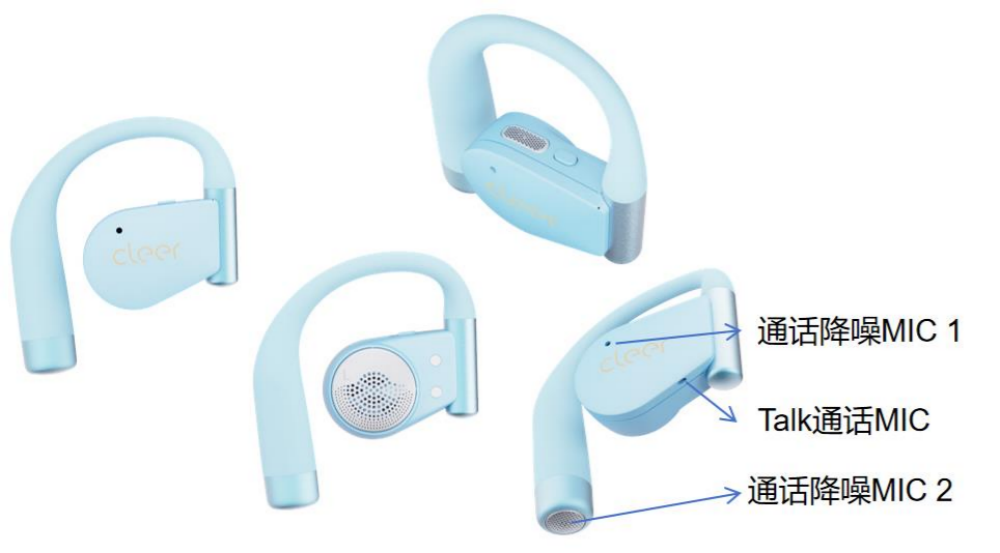2025-10-20 14:26:00
You may have used sports headphones, but have you heard of "cycling headphones"?
Every year on Singles' Day, various new headphones are released in rotation, but this year's most noteworthy is not the conventional sports headphones, but an open earphone tailored for "cycling" - Cleer ARC 5-tone arc open AI earphone cycling version..jpg)
Many people think that the difficulty with cycling headphones lies in waterproofing or wearing them, but the real challenge is the wind. If you often ride, you have probably experienced this scene: just put on headphones to answer a phone call, and when the wind rises, the call sound in the headphones instantly "disappears" - only the howling wind crazily brushing its presence in your ears.
Especially when the riding speed exceeds 20km/h, the airflow generated by the wind will continuously impact the microphone diaphragm, forming strong turbulent noise. This type of noise has no fixed frequency, changes quickly, and has strong randomness, making ordinary noise reduction algorithms almost powerless. Simply put, wind noise is not about the wind blowing, but about the wind hitting the microphone. As the riding speed increases, the airflow will impact the microphone surface with greater pressure. When the wind speed increases from 15km/h to 25km/h, which may seem like only 10 kilometers, the noise energy caused at the microphone end may actually increase exponentially.
The result is that the sound of the conversation is "swallowed up" by the wind, so the wind noise during cycling is actually more difficult to deal with than you imagine. The stronger and faster the wind, the more intense the noise; And it doesn't have a fixed frequency, making it difficult for algorithms to recognize.
How did the Cleer ARC 5 Cycling Edition handle such intense wind noise? Its intelligence lies in not simply relying on AI algorithms for "hard computing", but starting from the three aspects of structure, hardware, and AI simultaneously.
At present, open earphones on the market generally adopt a dual microphone design, and Cleer has added an additional independent noise cancelling microphone on this basis to form a three microphone array. Three point pickup can more accurately determine the spatial direction of sound and the source of wind noise, providing more analytical dimensions for AI algorithms. This is like changing from two ears to "three ears", which can more accurately determine the direction and intensity of wind noise, providing cleaner data for AI algorithms.
Secondly, its self-developed AI wind noise algorithm can analyze sound signals in real-time, identify which ones are wind noise and which ones are human voices, and then accurately filter out wind noise.
In addition, Cleer has also developed a "sandwich acoustic structure" - using two layers of transparent mesh cloth to sandwich a layer of porous acoustic resistance sponge. This structure acts as a noise "filter", which can "eat up" turbulent energy before the airflow contacts the microphone, preventing the wind from directly hitting the diaphragm and making it easier for AI algorithms to distinguish human voices.
Official data shows that this system can effectively reduce wind noise by up to 97%, with a maximum reduction of 30dB noise. Riding at 25km/h in a windless environment can still achieve clear communication. In other words, even if you are galloping in the wind, the person on the other end of the call will no longer hear the "whooshing" noise.
This "soft hard combination" anti wind noise solution is not only the industry's first systematic design for cycling scenarios, but also makes Cleer one of the few brands in the open earphone field that truly overcomes wind noise.
Many people are worried that open headphones may have a discount on sound quality? After all, traditionally, open headphones have a certain degree of sound leakage and the listening experience is prone to "drifting" because they are "not blocking the ears". That's why many people have a mixed love hate relationship with open headphones: they are comfortable, but the listening experience is always disappointing.
But Cleer continued its consistent advantage in sound quality with the ARC 5 Cycling Edition - dual certification of Dolby sound effects and THX spatial audio, both of which are hard currency in the audio industry: Dolby sound effects emphasize the sense of depth and surround sound, giving each note more direction and space; THX spatial audio ensures that the sound is closer to a "cinema level experience" in terms of dynamic range, distortion control, and spatial positioning.
Simply put, when you listen to electronic music, there is a feeling of "bouncing" in the low frequencies - the drum beats are clean and crisp, neither dull nor dull; When listening to human voices, the details are delicate and the breathing sensation is clear, as if the singer is singing softly in their ear. Even with an open design, Cleer is able to "shape" sound, allowing the presence of sound fields to be felt in the air.
Of course, Cleer is not satisfied with being "pleasant to listen to", it wants to be "pleasant to listen to at all times". The ARC 5 Cycling Edition is equipped with its self-developed AI sound environment constant listening technology, which adjusts the dynamics and EQ of music in real time according to changes in surrounding noise, truly achieving the same listening experience as the environment changes.
This means that whether traveling through busy city streets or riding against strong winds in the mountains, the headphones will intelligently adjust the sound balance, preventing low frequencies from being swallowed up by wind pressure and high frequencies from being excessively harsh.
And for other concerns about cycling, Cleer also takes them into consideration.
For cyclists, safety is always the top priority, but the closed headphones are like pressing the "mute button" on the world - danger can happen at any time. The biggest charm of the Cleer ARC 5 Cycling Edition as an open earphone is that it does not isolate the world, allowing you to listen to music while also hearing the outside world - car horns, pedestrians, and even bicycle ringtones, all of which will not be missed. This' semi immersive 'listening experience perfectly balances entertainment and safety. At the same time, the earphones have IPX7 waterproof capability, making them easy to handle whether it's sweaty riding or sudden heavy rain. Lightweight ear hanging design ensures no pain or discomfort when worn for a long time, and stable wear without falling off, which is crucial for long-distance cycling.
I tested it on the suburban road for a period of time. The wind speed is about 25km/h, and you can feel the obvious airflow, but the call effect of the headphones is still clear, and the other party can hardly hear the wind noise. When playing music in AI sound environment constant listening mode, the sound will increase with the increase of wind noise, and the low frequency will still be clean and powerful; When the environment is quiet, it can automatically return to natural sound. No manual adjustment is required throughout the entire process, and the listening experience is always online.
In the past, we had to choose between "sound quality" and "safety", but the Cleer ARC 5 Cycling Edition allows you to have both.
The Cleer ARC 5 Cycling Edition is not a conventional upgrade, but a redefinition of the "riding listening" scene. If you also love cycling, sports, and speed, then these headphones are really worth trying.
At present, Cleer ARC 5 Cycling Edition has officially landed in Cleer's official Tiktok live broadcast room, with limited time offers during the Double 11 Festival, and multiple gifts and benefits simultaneously launched. Hurry up and give it a try!